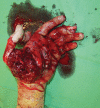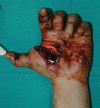Patterns in blast injuries to the hand
- PMID: 18780004
- PMCID: PMC2654959
- DOI: 10.1007/s11552-008-9125-z
Patterns in blast injuries to the hand
Abstract
Blast injuries to the hand are not just a wartime phenomenon but also quite common in rural communities throughout northern California. The purpose of this study is to review our experience with blast injuries in the community and review the most common patterns in an attempt to identify the pathomechanics of the hand injury and the reconstructive procedures that are required. This is a retrospective study of blast injuries to the hand treated between 1978 and 2006. Medical records, X-rays, and photos were reviewed to compile standard patient demographics and characterize the injury pattern. Explosives were classified based on their rate of decomposition. Reconstructive solutions were reviewed and characterized based on whether damaged tissues were repaired or replaced. Sixty-two patients were identified with blast injuries to their hand. Patients were predominantly male (92%) with an average age of 27 years. Firecrackers were the most commonly encountered explosives. Thirty-seven patients were identified as holding a low explosive in their dominant hand and were used for characterization of the injury pattern. The apparent pattern of injury was hyperextension and hyperabduction of the hand and digits. Common injuries were metacarpophalangeal and interphalangeal joint hyperextension with associated soft tissue avulsion, hyperabduction at the web spaces with associated palmar soft tissue tears, and finger disarticulation amputations worse at radial digits. Given the mechanisms of injury with tissue loss, surgical intervention generally involved tissue replacement rather than tissue repair. Blast injuries to the hand represent a broad spectrum of injuries that are associated with the magnitude of explosion and probably, the proximity to the hand. We were able to identify a repetitive pattern of injury and demonstrate the predominant use for delayed tissue replacement rather than microsurgical repair at the acute setting.
Figures







References
-
- {'text': '', 'ref_index': 1, 'ids': [{'type': 'DOI', 'value': '10.1016/j.jhsa.2005.12.009', 'is_inner': False, 'url': 'https://doi.org/10.1016/j.jhsa.2005.12.009'}, {'type': 'PubMed', 'value': '16632060', 'is_inner': True, 'url': 'https://pubmed.ncbi.nlm.nih.gov/16632060/'}]}
- Adani R, Tarallo L, Marcoccio I, Fregni U. First web-space reconstruction by the anterolateral thigh flap. J Hand Surg (Am). 2006;31:640. - PubMed
-
- {'text': '', 'ref_index': 1, 'ids': [{'type': 'DOI', 'value': '10.1097/00000637-200110000-00018', 'is_inner': False, 'url': 'https://doi.org/10.1097/00000637-200110000-00018'}, {'type': 'PubMed', 'value': '11601586', 'is_inner': True, 'url': 'https://pubmed.ncbi.nlm.nih.gov/11601586/'}]}
- Akyurek M, Safak T, Kecik A. Coverage of thumb wound and correction of first webspace contracture using a longitudinally split reverse radial forearm flap. Ann Plast Surg. 2001;47:453. - PubMed
-
- {'text': '', 'ref_index': 1, 'ids': [{'type': 'PubMed', 'value': '885018', 'is_inner': True, 'url': 'https://pubmed.ncbi.nlm.nih.gov/885018/'}]}
- Biemer E. Replantation of fingers and limb parts(:) technique and results. Chirurg. 1977;48:353. - PubMed
-
- {'text': '', 'ref_index': 1, 'ids': [{'type': 'PubMed', 'value': '17003215', 'is_inner': True, 'url': 'https://pubmed.ncbi.nlm.nih.gov/17003215/'}]}
- Bumbasirevic M, Lesic A, Mitkovic M, Bumbasirevic V. Treatment of blast injuries of the extremity. J Am Acad Orthop Surg. 2006;14(Suppl):S77. - PubMed
-
- None
- Buncke HJ. Digital reconstruction by second-toe transplantation. In: Buncke HJ, editor. Microsurgery: transplantation–replantation. An atlas text. Philadelphia: Lea & Febiger; 1991. p. 61–101.
LinkOut - more resources
Full Text Sources
Research Materials

